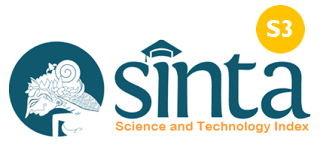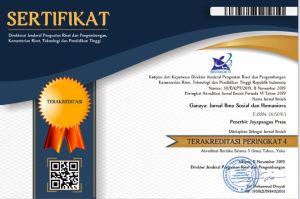Meningkatkan Keterampilan Berpikir Kreatif Melalui Model Pembelajaran Context-Based Learning (CBL) Pada Materi Dinamika Gerak
DOI:
https://doi.org/10.37329/cetta.v7i1.3035Keywords:
Berpikir Kreatif, Context-Based Learning (CBL), Dinamika GerakAbstract
One of the troubles in Indonesian training is that the system of tutorial development remains not substantial and is abstract and even a way from actual existence, making it tough to train college students' creative wondering abilties. This study targets to enhance innovative questioning talents using the context-based learning (CBL) studying model on motion dynamics fabric. There are several articles associated with these studies for analysis. The sample for this research was 64 students taken from 2 classes, namely class XI K and XI L among 6 class XI at SMAN 3 Pandeglang. The methodology employed for data analysis to ascertain an increase in creative thinking skills in students is the N-gain test. Based on the N-gain analysis, the findings indicated an improvement in creative thinking skills using the context-based learning (CBL) learning model on Motion Dynamics material. This was obtained derived from the outcomes of statistical calculations which indicated the presence of increase in the value of N-gain in the class undergoing the experiment by 0.84 in the high category, while in the control class the N-gain value was only 0.39 falling within the moderate category. Therefore, learning using the context-based learning model is recommended to be employed to enhance the creative thinking abilities of students, especially in contextually related materials such as Motion Dynamics material.
References
Ady, W. N. (2020). Analisi Kesulitan Belajar Siswa SMA terhadap Mata Pelajaran Fisika pada Materi Gerak Lurus beraturan. Jurnal Pendidikan dan ilmu fisika, 2(1), 104.
Fathurohman, A., & Luthfi, H.M. (2019). Analisis Proses Pembelajran Fisika Berbasis Problem Based Learning. Jurnal Pendidikan fisika, 10(2).
Fatihah, S.H., Mulyaningsih, N. N., & Astuti, I. A. D. (2020). Inovasi Bahan Ajar Dinamika Gerak dengan Modul Pembelajaran Berbasis Discovery Learning. Jurnal Pendidikan Fisika dan Teknologi, 6(2), 175–182.
Hwang, G. J., Chiu, L. Y., & Chen, C. H. (2015). A Contextual Game-Based Learning Approach To Improving Student’s Inquiry-Based Learning Performance In Social Studies Courses. Computers and Education, 81, 13–25.
Sholihah, Z., Saefuddin, A., & Rahmah, S. K. (2023). Pengaruh Penerapan Kreatif Peserta Didik Context Based Learning terhadap Kemampuan Berfikir kreatif peserta didik pada pembelajaran IPA di kelas IV. Aksara: Jurnal Ilmu Pendidikan Nonformal. Vol 09(1).
Kim, K. H., Cramond., & Bandalos, D. L. (2006). The Latent Structure And Measurement Invariance Of Scores On The Torrance Tests Of Creative Thinking-Figural. SAGE Publications Inc.
Idawati & Yulianti, L. (2019). Authentic Learning Berbasis Inquiry dalam Program STEM terhadap Literasi Saintifik Siswa Berdasarkan Tingkatan Kemampuan Pemecahan Masalah Siswa. Jurnal Pendidikan: Teori, Penelitian, dan Pengembangan (Volume: 4 Nomor: 8).
Madyani, I., Yamtinah, S., & Utomo, S. B. (2019). The Implementation Of PBL Integrated With STEM In The Material Of Temperature And Its Changes To The Improvement Of Students Creative Thinking Skills And Learning Results. Journal of Educational Science and Technology (EST), 260–267.
Chanifudin., Nuriyati, T. (2020). Integrasi Sains Dan Islam Dalam Pembelajaran. Asatiza Jurnal Pendidikan (Vol 1, No2, Mei - Agustus 2020)
Pongchano, P., Jansawang, N., & Chomchid, P. (2017). A Study of Contetx-Based Learning Activity Model on Chemical Reaction Issue for Secondary Students at the 10TH Level. European Journal of Education Studies.
Pratiwi, I. (2021). Hubungan Penguasaan Konsep Dan Sikap Ilmiah Peserta Didik dalam Pembelajaran berbasis Laboratorium Virtual di Masa Pandemi Covid-19. Jurnal Kumparan Fisika, 4(3), 177–184.
Priyambodo, M., Probosari, R. M., & Indriyanti, N. Y. (2021). Hubungan Kepercayaan Diri dan Adversity Qoutient dengan Keterampilan Berpikir Kreatif Siswa Kelas VIII pada Materi Gerak dan Gaya. Phenomenon: Jurnal Pendidikan MIPA, 11 (2), 231–244.
Rohmawati, E., Widodo., W., Agustini, R., & Korespondensi, A. (2018). Membangun Kemampuan Literasi Sains Siswa Melalui Pembelajaran Berkonteks Socio-Scientific Issues Berbantuan Media Weblog. Jurnal Penelitian Pendidikan IPA (Vol.3 No.1 2018).
Rosdiana, H., Ruhiat, Y., Firman Septiayanto Pendidikan Fisika, R., & Sultan Ageng Tirtayasa, U. (2020). Pengembangan Media Pembelajaran Video Animasi Berbasis Kontekstual Pada Konsep Dinamika Gerak Prosiding Seminar Nasional Pendidikan Fisika Untirta. In Prosiding Seminar Nasional Pendidikan Fisika (Vol. 3, Issue 1).
Setiawan, A., Guru, P., Ibtidaiyah, M., Nurul, S., Sukaraja, H., & Timur, O. (2020). Pengaruh Model Pembelajaran CTL (Contextual Teaching and Learning) Terhadap Hasil Belajar Siswa Pada Subtema 1 Tema 2 Kelas V SD 1 Nusa Bakti Kecamatan Belitung III Kabupaten Oku Timur. Jurnal Edukasi Madrasah Ibtidaiyah, 2(2), 108-119
Swirski, H., Baram-Tabasari, A., & Yarden, A. (2018). Does Interest Have An Expiration Date? An Analysis Of Students’ Questions As Resources For Context-Based Learning. International Journal of Science Education, 40(10), 1136–1153.
Treffinger, D. J., Renzulli, J. S., & Feldhusen, J. F. (1971). Problems in the Assessment of Creative Thinking. The Journal of Creative Behavior, 5(2), 104-112.
Trimmer, W., Laracy, K., & Love-Gray, M. (2009). Seeing the bigger picture through context-based learning. Good Practice Publication Grants.
Zaky, A. G.S., Wahono. W., & Sifak. I. (2021). Contextual Based Learning Media Development to Train Creative Thinking Skill in Primary School. IJORER: International Journal of Recent Educational Research, 2(4), 468-476.
Zuhri, M. M., Adnan, A., & Saparuddin, S. (2023). Analisis Kemampuan Literasi Sains Peserta Didik SMA Kelas X IPA di Kota Makassar dalam Menyelesaikan Soal PISA. Bioscientist : Jurnal Ilmiah Biologi, 11(2), 1892.
Downloads
Published
How to Cite
Issue
Section
License
Copyright (c) 2024 Hairiyah Hairiyah, Kinkin Suartini, Taufiq Al Farizi

This work is licensed under a Creative Commons Attribution-ShareAlike 4.0 International License.
An author who publishes in the Cetta : Jurnal Ilmu Pendidikan agrees to the following terms:
- Author retains the copyright and grants the journal the right of first publication of the work simultaneously licensed under the Creative Commons Attribution-ShareAlike 4.0 License that allows others to share the work with an acknowledgement of the work's authorship and initial publication in this journal
- Author is able to enter into separate, additional contractual arrangements for the non-exclusive distribution of the journal's published version of the work (e.g., post it to an institutional repository or publish it in a book) with the acknowledgement of its initial publication in this journal.
- Author is permitted and encouraged to post his/her work online (e.g., in institutional repositories or on their website) prior to and during the submission process, as it can lead to productive exchanges, as well as earlier and greater citation of the published work (See The Effect of Open Access).
Read more about the Creative Commons Attribution-ShareAlike 4.0 Licence here: https://creativecommons.org/licenses/by-sa/4.0/.





